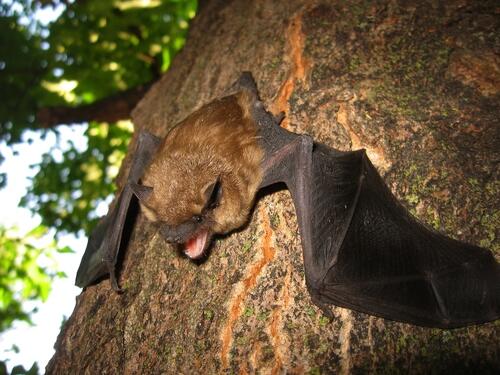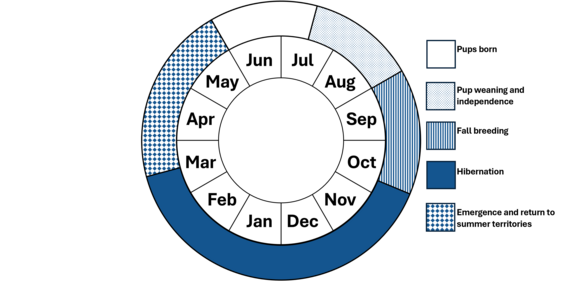- Scientific name: Eptesicus fuscus
- Species of Greatest Conservation Need (MA State Wildlife Action Plan)
Description

Big brown bat (Eptesicus fuscus)
The big brown bat has long, glossy, chocolate brown fur above with lighter-colored belly hairs that are darker at the base. The wing membranes, ears, feet, and face are dark brown to black. The wingspan ranges from 280-330 mm (11-13 in); the body length is 102-127 mm (4 -5 in). The forearm is 44-50 mm (1.7-2.0 in) in length.
Similar species: As its name implies, the big brown bat is one of the largest of the 9 species of bats found in Massachusetts. Only the hoary bat is larger. Excluding the three species of tree bats, all the others are generally some shade of brown. The size of the big brown bat is distinctly larger than all the others.
Life cycle and behavior
Big brown bats are insectivores. They have a varied diet, but beetles and stink bugs have been found to comprise the majority of their prey (Whitaker 1995). In the evening, they leave their roost site to hunt, usually within 1.6 km (1 mile), but may travel as far as about 6.4 km (4 miles). Males and some females are sexually mature in their first year. They are weakly social, with females forming maternity colonies of just a few individuals, up to about 50, and rarely more. Each female gives birth to one or two young, usually born in May and June. The young usually leave the nursery colony in late July and August but may remain with the colony until the arrival of cold weather.

Population status
The big brown bat is the most common and widespread species of bat in Massachusetts. Although not as dramatically affected as other species of bats in Massachusetts, its abundance has declined since 2007 due primarily to white-nose syndrome which killed most of the big brown bats that hibernated in caves and mines.
Distribution and abundance
The big brown bat occurs throughout all 48 contiguous states in the U.S., across most of southern Canada, most of Mexico, and some of the islands in the West Indies. In Massachusetts, records of big brown bats have been confirmed in each of the 14 counties and 333 of 351 towns.
Habitat
Big brown bats are habitat generalists, using a wide range of habitats from urban to rural. They are often most abundant in areas of farmland and are much more common in areas of deciduous forest than they are in areas of conifers. They are the most common bat in suburban neighborhoods. Here they gather in maternity colonies in large hollow trees, as well as buildings. Lone males are frequently found roosting nearby behind window shutters, under the eaves of sheds, in stacked firewood, and similar places. The big brown bat is the only bat in Massachusetts that commonly hibernates in buildings, especially the attics of houses.
Healthy habitats are vital for supporting native wildlife and plants. Explore habitats and learn about conservation and restoration in Massachusetts.
Threats
Big brown bat is one of seven bat species in the United States and Canada to have been confirmed with white-nose syndrome. Among the bats affected by white-nose syndrome in Massachusetts, big brown bats are the least affected, because many, and probably most, big brown bats in Massachusetts hibernate in attics and similar unheated locations in houses. Like caves and mines, attics remain cool, but above freezing, all winter. Since the fungus that causes white-nose syndrome is a soil fungus that requires moist conditions, it is unable to survive in the dry conditions of attics. Big brown bats hibernating in attics are not exposed to the fungus and remain healthy. That said, big brown bat populations have declined noticeably in Massachusetts since 2007.
Conservation
In Massachusetts, it is unlawful to deliberately kill any species of bat. However, it is lawful to evict a colony of bats from a home during periods when they are not hibernating, or they are not caring for babies that are too young to fly. This means that colonies should only be evicted in May or from the first of August to mid-October (MassWildlife 2020).
References
MassWildlife. 2020. Homeowner’s Guide to Bats. Massachusetts Department of Fisheries & Wildlife: Westborough, MA. 26 pp.
U.S. Fish & Wildlife Service. 2012. “White-nose Syndrome.”
Whitaker, J.O. Jr. 1995. Food of the big brown bat Eptesicus fuscus from maternity colonies in Indiana and Illinois. American Midland Naturalist 134:346-360.
Whitaker, J.O., Jr. and W.J. Hamilton, Jr. 1998. Mammals of the Eastern United States, Third Edition. Cornell University Press, Ithaca, NY. 583 pp.
Contact
| Date published: | March 4, 2025 |
|---|